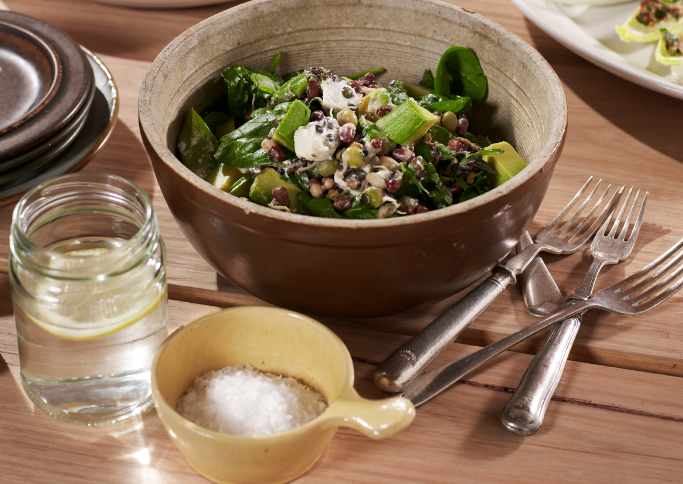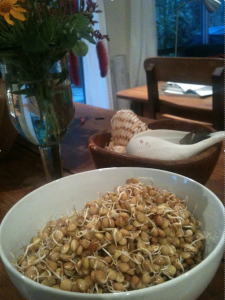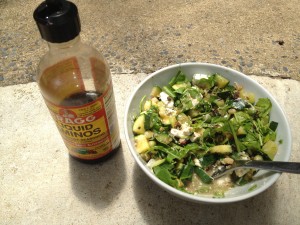Slide into your Birkenstocks, tie on your recycled bamboo apron and turn up Steely Dan on the stereo (or tune to Portlandia on ABC) because today we’re sprouting legumes!
If you were the kid with the mushroom kit or the Venus flytraps on your windowsill that you’d race home from school to just sit and… watch, you’ll love sprouting. If you rather like watching any creation you’ve made grow, you’ll love sprouting, too. So much veiw-able gratification as they do their sprouty thing.
The rest of you? Read on to see why it’s a good idea to try this cooking technique. And scroll below for some recipes. Me, personally, I avoid eating too many legumes: I find them super rough on my guts. Sprouting is certainly the best approach I’ve found for making them a smoother experience.
First, why sprout?
Sprouting kills toxins
Phytic acid, a toxin found in the fibre of legumes, leaches calcium, magnesium, iron, copper and zinc from our bodies. Not great. Sprouting neutralises this nasty acid (as does soaking before cooking). It also inactivates aflatoxins – potent carcinogens – in grains.
Sprouting increases vitamins
It increases the amount of B vitamins and carotene in the little beady things. Vitamin C is also created in the process.
Sprouting (almost) fixes the farting issue…
….because the complex sugars responsible for intestinal gas are broken down into simpler glucose molecules.
Sprouting alkalises
I’ve shared about why eating more alkalising foods is a good thing before. Legumes tend to be acid forming but by sprouting them you are effectively making a plant…and plants are always alkalising.
Sprouting increases enzymes
Legumes – the nasty little things – also contain enzyme inhibitors, which unfortunately not only inhibit enzymes in the actual seed, but can also inhibit your own valuable enzymes once they have been eaten. So sprouting first neutralises these WHILE ALSO adding extra enzymes into your system. This helps your digestion immeasurably…but also…
Sprouting slows aging
I’ve written about how more enzymes = less aging in last week’s post (a simplistic reading of things, to be sure). Have a read here to get the drift.
But a word of caution
Now. Sit down here and take heed, my child. You don’t want to eat too many raw sprouted legumes. Don’t go overboard. They still contain a few toxins… and can bring on the farting issue if consumed in bulk. The best idea is to also cook your sprouts where possible. I braise or steam mine, or add them to stews and soups. See below for more.
sprouted legumes
1 cup of dried legumes (chickpeas, brown lentils, mung beans work really well)
Water
Soak the legumes in the water overnight. In the morning drain and rinse in a wire sieve. Leaving the legumes in the sieve, prop the sieve over a bowl and put a saucepan lid over the top. Leave on the bench for 2-3 days, rinsing twice a day (I rinse really well, filling the bowl with water up and over the legumes and stirring up a little before draining). In summer, you’ll need to rinse more often. White shoots will start to form after a day or so. Once they’re about 1/2 cm long, put in a storage container in the fridge.
Things to do with ya sprouts
* steam lightly and then sprinkle on a salad
* Toss through stirfries or casseroles or soups
* For a snack. Braise in a little chicken stock (I freeze in icecube trays for just this purpose) and a dash of Liquid Aminos or tamari.
* Add to a mish-mash meal. Steam some veggies (broccoli or zucchini) and the sprouts or braise as above (with some Liquid Aminos) and then toss through 1/2 a chopped avocado, feta and rocket…perhaps some capers…
* Try this recipe for Teriyaki Lentils.
* Or this one for a curried sprouted lentils recipe (topped with a coriander sauce)
* Or check out the recipes in Sally Fallon’s Nourishing Traditions
Do you sprout? Any tips? What do you do with them? Fixes the farting issue? OK, maybe that goes too far…




